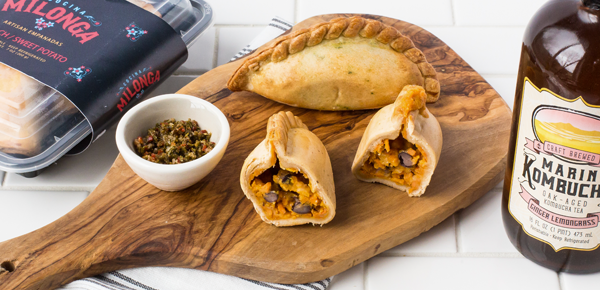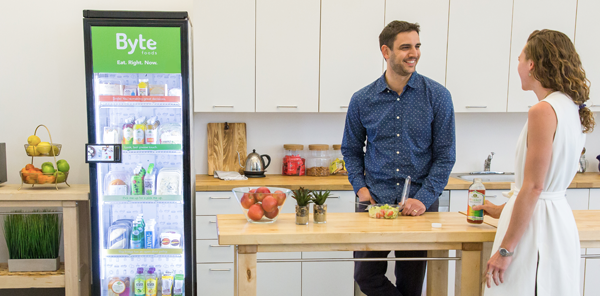Five Lessons Learned from Deploying 500+ Unattended Retail Stores
In this post we’re pulling back the curtain. We’re sharing lessons we’ve learned operating 500+ stores that generated nearly $10M in revenue, and how to avoid some of the obstacles we faced while scaling the business using Byte Technology’s unattended retail platform. You’ll learn:
- How to sell the service and close 50+ locations per month
- How we optimized delivery schedules to boost sales and reduce waste
- Why traditional vending machines just don’t cut it for fresh food
- Why flexible pricing helped us land dozens of partnerships
The most logical place to start is with a lesson that was the linchpin to our business.

1. Fresh Food is a Must Have for Workplaces
To get our first Byte Foods stores deployed in 2016, we called local offices and offered to set up a Byte store at no cost to the business. We saw immediate traction. Of course they wanted fresh food on-site. Within a few weeks, we had 20 locations generating revenue around the Bay Area.
But we weren’t sure of our long-term pricing strategy. Would offices be willing to pay a set fee to have fresh food in the office? We saw companies like Facebook and Google spending millions of dollars a month to provide fresh food to employees. They were clearly seeing a ROI, enabling their teams to be more productive, happier and healthier by simply offering the perk to employees. Until Byte Foods, companies had very few options - either not offering anything, or 100% subsidizing (giving away) food for employees. We saw that 99% of companies weren’t offering fresh food to their employees because it was too expensive to do so. This was a significant pain point, and a tremendous opportunity.
That put Byte Foods’ value proposition into perspective. There was clear demand for fresh food in the office and for the first time, the cost could be passed along to the customer. These insights informed our pricing strategy to begin charging a monthly ‘subscription’ fee for our completely turnkey service.
As demand grew month over month, we saw companies for whom this was never an option begin offering fresh meals at work. We saw traction in the usual places of technology, finance, services industries, but also in places you wouldn’t expect like manufacturing, government agencies and non-profits.
Takeaway: Workplaces understand the value and impact of having fresh food on-site—and they’re willing to pay for it.
-----

2. Optimize Delivery Frequency and Time
We were overly cautious at first when it came to food spoilage, making deliveries and inspecting products every single day. Our food, however, didn’t require that frequent attention. Our average shelf life hovered around 3-7 days before losing quality and freshness. That meant we could deliver as little as twice per week without compromising on the customer experience. On average, we now make three deliveries per week to our Byte Foods stores - some stores receive more frequent deliveries due to sell through, others fewer deliveries.
At first, all deliveries happened in the morning because everyone wanted to start off the day with a freshly stocked store. This created huge peaks on our delivery routes, which hurt efficiency and caused deliveries to be pushed back later and later into the day. We solved the issue by moving the majority of our deliveries to after-hours, smoothing out the delivery peaks and eliminating issues around traffic or our drivers being a distraction for the employees. It also removed any driver hiring bottlenecks, where we could make more deliveries with fewer drivers.
Takeaway: Delivering food after-hours and at a frequency matched to sell through at a given location has proven to be the most efficient and cost-effective way to restock.
----
.jpg)
3. Traditional and Next-Gen Vending Machines Just Don’t Cut It
Byte Foods sources all its food from third-party suppliers - we’re like a mini Whole Foods in an office. Between variously sized drinks, meal packages, and snacks, it was important that our store wasn’t restricted by pre-sized slots. Even newer, more versatile vending machines couldn’t handle the diverse range of products we were offering.
We realized our stores couldn’t just be a redesigned vending machine. The store had to allow for different formats and form factors. Shelving slots that expand and retract for any size products, from meal-kits to snacks and drinks. A technology platform capable of allowing a variety of products in a single row, so you no longer have to stock a single SKU “all the way back.” And connected to the internet, so the operator can see inventories across an entire fleet of fridges in real-time, see product expiration dates, change product pricing and much more.
Takeaway: Your technology partner can make or break the success of your business. We never could have gotten to 500 stores had we gone with a less flexible, traditional vending machine.
-----
4. Pricing Should Be Highly Customizable
Some of our customers wanted to be able to subsidize the food by 10%, others by 25%, and others by more. There were requests for employee allowances, incentive discounts, and company sponsored happy hours. Some clients wanted to subsidize food just for the graveyard shift.
Being able to provide flexible per-location pricing models helped us land dozens of customers. Our food wasn’t limited to simply being an amenity, but a tool that offices could use to drive employee satisfaction and build culture.
Takeaway: Giving businesses flexibility over the food pricing caused them to see our stores as an opportunity to create value for employees, rather than just another food option.
----

5. Precise Food And Sales Data Is Non-Negotiable
We knew every location would want their own unique food mix — we just didn’t so much customization. Indian dishes, for example, sold tremendously well in 20% of our stores, but it flopped in 80%. Instantly turning off Indian dish stocking at those locations cut our waste dramatically, which improved our overall margins—all thanks to granular data provided by Byte Technology’s platform.
This data enabled us to accomplish things that would have been impossible otherwise:
- We learned to identify per-location preferences. It wasn’t only salad. Some locations saw strong demand for breakfast sandwiches each morning. Other locations tended to have more employees stay late for dinner. We saw, then anticipated these trends and adjusted product selection quickly.
- We caught product fatigue early. People get tired of eating the same things day-in and day-out. When an office began losing preference for an item, we noticed declining sales in the data and swapped it out with something new and seasonal to get consumers excited again.
- We accurately tracked food spoilage. With each delivery, the Byte Technology platform automatically records products that did not sell and are removed from the store. In addition, we can see how long each product has sat on the shelf and be proactive with discounting. All of this adds up to building a more profitable business while offering a great experience to our customers.
- We created predictive sales algorithms for optimized purchasing. These models tracked historical sales and spoilage data, current shelf life and expected demand to help inform ordering, minimize spoilage and inform stocking across every store.
Managing inventory and demand can’t be done in an Excel spreadsheet when you have hundreds of stores in the field. Having real time data and demand planning from the Byte Technology platform was key.
Takeaway: The key to reducing food waste, purchasing the right products on a per-location basis, and maintaining control of back-end operations comes down to accurate, actionable data.
---
We’re thrilled to be working with so many retailers around the country to extend the reach of their products into locations they never had access to before. As retail moves from in-store and online to on-demand and “at hand” through Byte Technology stores, it’s clear unattended retail in workplaces is the right solution for brands to expand beyond traditional brick-and-mortar stores.
Ready to extend the reach of your products into local businesses?

